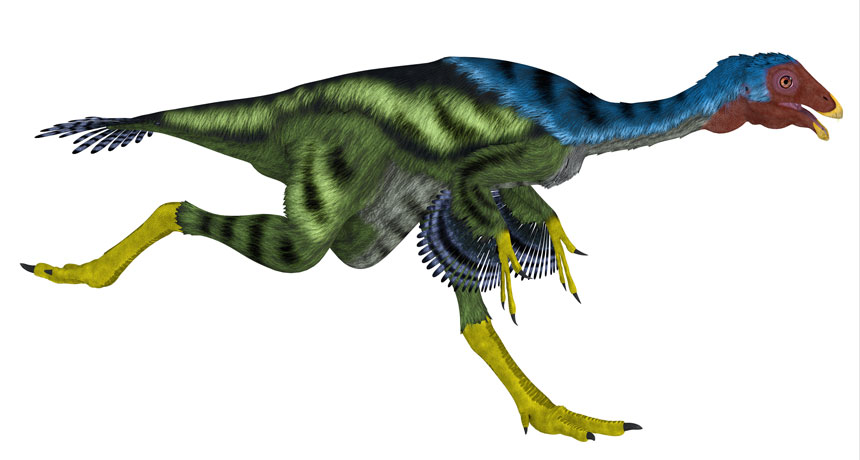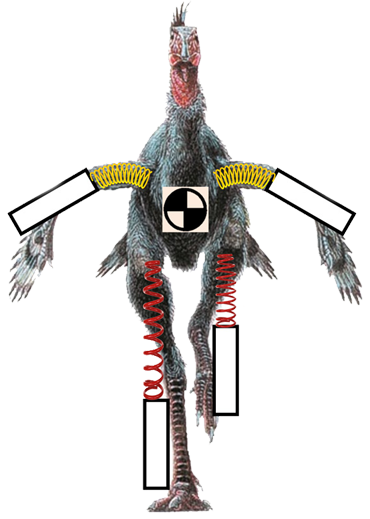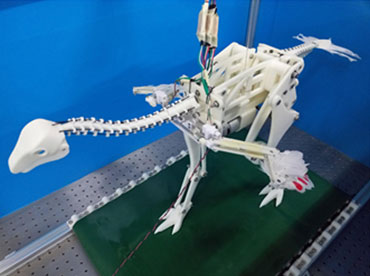A dinosaur’s running gait may reveal insights into the history of bird flight
A robot and ostriches with fake wings model Caudipteryx’s flapping stride

MEEP MEEP Caudipteryx, a peacock-sized dinosaur (illustrated) that lived about 125 million years ago, was a fast runner. The jostling from its gait may have caused its feathery forelimbs to flap, in a possible precursor to active flapping, a study finds.
Corey Ford/Alamy
An early winged dinosaur couldn’t fly, but it could run. Now, with assists from a robotic dino and young ostriches wearing artificial wings, a study suggests that the dinosaur’s running gait caused its wings to flap, in what may have been an evolutionary precursor to flight.
Caudipteryx was a peacock-sized dinosaur with feathered and winglike forelimbs that lived about 125 million years ago. Running at speeds of about 2.5 to 5.8 meters per second sent vibrations through its body, causing its wings to flap vigorously, scientists report online May 2 in PLOS Computational Biology. If true, the results suggest that some dinosaurs had to run before they could fly — adding a new wrinkle to a long-standing debate over whether the earliest fliers were flappers or gliders.

Some researchers have suggested that the delicate, thin shafts in the feathers of primitive birds such as Archaeopteryx, which lived about 150 million years ago, wouldn’t have stood up to rigorous flapping, and so those animals probably glided between trees (SN: 6/5/10, p. 12). Other researchers analyzing the wing length, light bodies and powerful hind limbs of early winged dinosaurs such as Microraptor, which lived about 120 million years ago, suggest that these early fliers could have launched themselves into the air rather than needing to gently glide (SN: 10/26/16, p. 9). And a recent study of the wings of Archaeopteryx found that, feathers aside, its arm bones were strong enough to withstand short bursts of active, flapping flight (SN: 4/14/18, p. 9).
The new study takes a different tack, turning from the anatomy of early fliers to that of a dinosaur unable to fly, although it had an early form of wings. Caudipteryx looks about as much like Archaeopteryx as an ostrich does a sparrow, with a body far too large for its small, winglike forelimbs. But like Archaeopteryx, it was a maniraptoran, a group of dinosaurs that includes birds and some nonavian dinosaurs. Caudipteryx also had several birdlike features, including pennaceous feathers on its forelimbs like the feathers of modern birds, with barbs spreading out to the side from a central quill.
Like modern ostriches or emus, Caudipteryx was probably a pretty fast runner, says study coauthor Jing-Shan Zhao, a mechanical engineer at Tsinghua University in Beijing. These factors made the dinosaur the right candidate to examine how running might have played a role in the evolution of flight.
In particular, Zhao and his colleagues wanted to see how Caudipteryx’s running gait might have jostled its forelimbs, perhaps causing them to flap involuntarily. Hypothetically, with strong enough vibrations — and if the wings were large and strong enough — such flapping could generate enough lift to leave the ground.
That’s a mechanics problem, so the researchers took a mechanical approach. Led by Yaser Saffar Talori, a mechanical engineer also at Tsinghua University, the team considered the dinosaur as a simplified system of masses and springs. The researchers divided the dino into different bits of mass — body, right and left wings, right and left legs, neck and head, and tail — and then imagined that each of those bits of mass were attached to the others by springs. Jostling caused by running would produce vibrations throughout the body.
Based on its skeletal proportions, the team estimated that Caudipteryx could reach a maximum running speed of about 8 meters per second. But simulations suggested that even at lower speeds from about 2.5 to 5.8 meters per second, the dinosaur’s gait would have created strong enough vibrations that caused its wings to flap.
Robo-dino and living ostriches put that conclusion to the test. After building a life-size robotic Caudipteryx, the researchers put it to work on a treadmill. And they outfitted several young ostriches — each about the same weight as a middling Caudipteryx, at 5 kilograms — with artificial wings equipped with sensors that could detect the forces of lift and thrust, or drag, and watched the birds run. The team also tried out five different feather sizes on the wings.
These additional tests, Zhao says, validated the simulation’s results: Caudipteryx would have flapped its wings as it ran. And the artificial ostrich wing tests revealed that the longer the feathers were, the greater lift that the ostriches could get, although they never got nearly enough lift to actually get off the ground. The results suggest that this passive wing flapping may have been an evolutionary precursor to later active wing flapping, Zhao says.

Other researchers aren’t so sure. Caudipteryx lived about 25 million years after the first bird ancestors, such as Archaeopteryx, began to fly, so the dinosaur isn’t a direct ancestor of birds. “We cannot consider its morphology as a 100 percent valid model for the ancestral bird,” says Andrea Cau, a vertebrate paleontologist who is a collaborator with the Giovanni Capellini Paleontological Museum in Bologna, Italy. But, he adds, “it would be interesting to apply this model to a large sample of feathered dinosaurs.”
The role of passive flapping in the evolution of flight is indeed a novel question, and the suite of methods that the team used is “ambitious and creative,” says John Hutchinson, an evolutionary biomechanicist at the Royal Veterinary College in London.
But, he says, he wasn’t convinced by the study that Caudipteryx must have flapped its wings while running. For one thing, he says, the study’s simplification of a bird into masses and springs raises the question of “how biologically relevant the motions are, since animals are far more complex than that.” For example, the animal might have avoided the drag due to passive flapping by using its muscles to hold its forelimbs closer to its body.
And passive flapping may represent only a modest incremental step between two bigger milestones among the ancestors of birds: bipedal running and active flapping, Hutchinson adds. “However, this study does lay groundwork that could be built upon and tested more rigorously. So perhaps it will inspire deeper insight in the future.”
Editor’s note: This story was updated May 3, 2019, to clarify the dinosaurs included among the maniraptorans.







